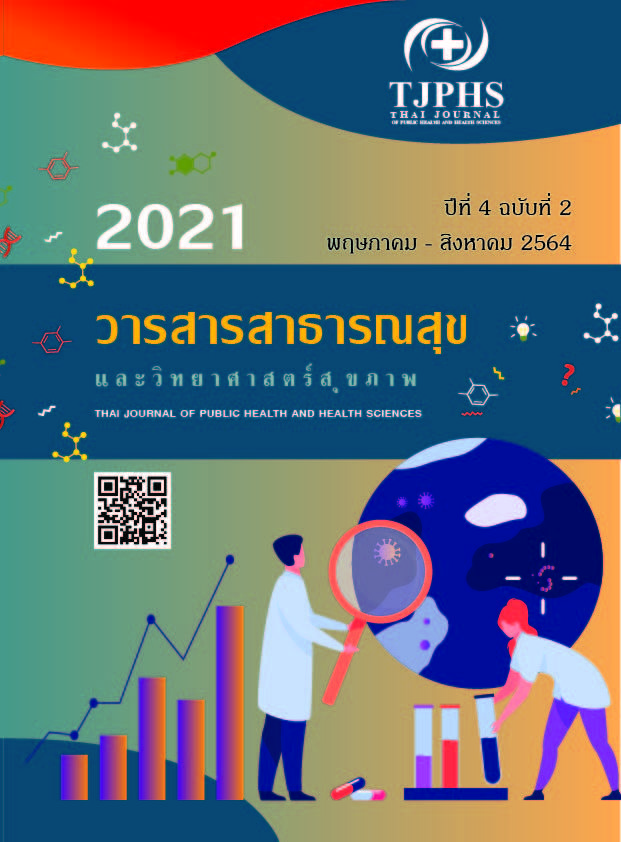การปรับเปลี่ยนพฤติกรรมสุขภาพของผู้ป่วยจิตเวชที่มีภาวะโภชนาการเกินร่วมกับ โรคเบาหวานหรือโรคความดันโลหิตสูง โดยการมีส่วนร่วมของครอบครัว
คำสำคัญ:
การปรับเปลี่ยนพฤติกรรมสุขภาพ, ภาวะโภชนาการเกิน, ผู้ป่วยจิตเวช, การมีส่วนร่วมของครอบครัวบทคัดย่อ
การวิจัยเชิงปฏิบัติการนี้มีวัตถุประสงค์เพื่อศึกษาพฤติกรรมสุขภาพของผู้ป่วยจิตเวชและการมีส่วนร่วมของครอบครัวในการปรับเปลี่ยนพฤติกรรมสุขภาพ เลือกกลุ่มเป้าหมายแบบเจาะจงเป็นผู้ป่วยจิตเวชที่มีภาวะโภชนาการเกินร่วมกับมีโรคเบาหวานหรือโรคความดันโลหิตสูง อายุ 20-59 ปี ที่คลินิกจิตเวชโรงพยาบาลห้วยยอด ตุลาคม 2559 – กรกฎาคม 2562 จำนวน 24 คน ประกอบด้วยผู้ป่วย 12 คน และสมาชิกในครอบครัว 12 คน เครื่องมือที่ใช้ในการวิจัย คือ โปรแกรมการปรับเปลี่ยนพฤติกรรมสุขภาพ ด้านการรับประทานอาหาร การออกกำลังกาย และการจัดการกับอารมณ์ จำนวน 5 ครั้ง ระยะเวลา 15 สัปดาห์ รวบรวมข้อมูลโดยใช้แบบสอบถาม แบบประเมินพฤติกรรมสุขภาพ และแบบบันทึกสภาวะสุขภาพ วิเคราะห์ข้อมูลใช้สถิติ เชิงพรรณนาสถิติ Wilcoxon Signed Ranks Test และ Pair Sample t-Test
ผลการศึกษาพบว่าคะแนนการมีส่วนร่วมของครอบครัวในการสนับสนุนการปรับเปลี่ยนพฤติกรรมสุขภาพและคะแนนการปรับเปลี่ยนพฤติกรรมสุขภาพโดยรวมของกลุ่มเป้าหมาย ก่อนและหลังเข้าโปรแกรมแตกต่างกันอย่างมีนัยสำคัญทางสถิติ (p-values < .05) คะแนน พฤติกรรมสุขภาพด้านการรับประทานอาหารและด้านการออกกำลังกาย มีความแตกต่างกันอย่างมีนัยสำคัญทางสถิติ (p-value < .05) ส่วนด้านการจัดการกับอารมณ์ ไม่มีความแตกต่างอย่างมีนัยสำคัญทางสถิติ (p-value > .05) แสดงว่าโปรแกรมปรับเปลี่ยนพฤติกรรมสุขภาพมีผลให้ครอบครัวมีส่วนร่วมในการปรับเปลี่ยนพฤติกรรมสุขภาพผู้ป่วยจิตเวชให้ดีขึ้นในด้านการรับประทานอาหารและการออกกำลังกาย
เอกสารอ้างอิง
Khamchata, L., Dumrongpakapakorn, P. & Theeranut, A. (2018). Metabolic
Syndrome : Dangerous signs required management. Srinagarind Medical Journal, 33(4): 386-95. Retrived April 5, 2019 from file:///C:/Users/WIN-7/Downloads/130307-Article%20Text-342997-1- 10-20180624%20(5).pdf. (In Thai)
Ittasakul, P. (2012). Risk of overweight and obesity in psychiatric patients, Rama Medical Journal, 35(2): 67-69. Retrived August 16, 2018 from
http://www.ramamedj.com/form2/RamaMedJ%2035%20No%202%
-%201.pdf. (In Thai)
Newcomer, J.W. (2004). Metabolic risk during antipsychotic treatment. Clin
Ther. 26(12):1936-46. doi: 10.1016/j.clinthera.2004.12.003.
PMID: 15823759. Retrived August 16, 2018 from
https://pubmed.ncbi.nlm.nih.gov/15823759/.
Wei Xin Chong, J., Hsien-Jie Tan, E., Chong, C.E., Ng, Y., Wijesinghe, R. (2016).
Atypical antipsychotics: A review on the prevalence, monitoring, and
management of their metabolic and cardiovascular side effects.
Ment Health Clin, 6(4):178-184. doi: 10.9740/mhc.2016.07.178.
PMID: 29955467; PMCID: PMC6007719. Retrived July 10, 2018 from
https://pubmed.ncbi.nlm.nih.gov/29955467/.
Wongpakaran, R., Boonlue, T. (2015). Psychotopic drugs induce weight gain.
Srinagarind Med J, 30(3): 313-318. (In Thai)
Young, A.S., Cohen, A.N., Goldberg, R., Hellemann, G., Kreyenbual, j., Niv, N.,
Nowlin-Finch, N., Oberman, R., Whelan, F. (2017). Improving weight
in people with serious mental illness: the effectiveness of
computerized services with peer coaches. Published online March,
: S48-S55. Retrived July 12, 2018 from
https://link.springer.com/content/pdf/10.1007/s11606-016-3963-0.pdf.
Allison, D.B., Mackull, T.A. & Mc Donell, D. (2003). The impact of weight of gain on quality of life among persons with schizophrenia. Psychiatric Services, 54(4): 565-7. Retrived July 12, 2018 from https://ps.psychiatryonline.org/doi/pdf/10.1176/appi.ps.54.4.565.
World Health Organization. (2018). Noncommunicable disease country profile
Retrived April 5, 2019 from https://apps.who.int/iris/rest
/bitstreams/1151362/retrieve.
Uthaipattanacheep, W., Khumthong, T., Amphairit, P., Ranoi, T. & Hirasatsunthorn, S. (2013).Community-basedhealth behavior modification. Bangkok: Health Education Division. Retrived January 18,2019fromfile:///C:/Users/WIN-7/Downloads/080420151827426585
_linkhed%20(1).pdf. (In Thai)
Lakkanasirorat, M., Ongpalakorn, C., Lukkanawiwat, J., Negkaphat, P.,
Wongyongsil,S. (2018). The prevalence diabetes mellitus and
hypertension in psychiatric patiens. The 6th Seoul International
Congress of Endocrinology and Metabolism. SICEM, April, 2018.
SICEM2018-P-038. (In Thai)
Quality improvement center for workforce development. (2009). Clinical
Nursing Practice Guidline for management in relapsed psychiatric patients. Huaiyot Hospital, Trang, Thialand. (in Thai).
Thongtub, S. (2017). Reduce belly disease manual. Bangkok: Health Learning
Center Building; Retrived Janualy 12, 2018 from http://detudomhospital.org/hospital-detudom/web/index.php?r
=upload-general%2Fdownload&id=153. (In Thai)
Saetew, P. & Waichompu, N. (2017). Success with Three Main Concepts.
Journal of The Royal Thai Army Nurses. 18 (Supplement) : 9-16.
Young, A.S., Cohen, A.N., Goldberg, R., Hellemann, G., Zreyenbuhl, J., Niv, N. & et al. (2016). Improving Weight in People with Serious Mental Illness: The Effectiveness of Computerized Services with Peer Coaches. Journal of General Internal Medicine, 32(1): 48–55. Retrived Faburary 12, 2020 from https://www.ncbi.nlm.nih.gov/pmc/articles/
PMC5359157/pdf/11606 2016 Article 3963.pdf.
Rachadara, P. (2009).Learning Outcomes of Family Paticipation on Self-Care Behavior On Type II Diabetic Patients at Home. [M.Sc. Thesis in Community Nurse Practitioner]. Bankok: Faculty of Graduate studies, Chistain Univesity, Retrived August 14, 2018 from http://library.christian.ac.th/thesis/document/T027991.pdf. (In Thai)
Charoen, R., Pakdevong, N. & Namvongprom. (2010). A. Effects of a Knowledge Development and Family Participation Program on Health Behaviors and Glycemic Control in Older Persons with Type 2 Diabetes, Thailand. Ramathibodi Nurse Journal, 16(2): 279-292, Retrived March 26, 2018 from https://med.mahidol.ac.th/nursing /sites/default/files/public/journal/2553/ issue_02/08.pdf. (In Thai)
Kanfer, F. H. & Gaelick-Buys, L. (1991). SeIf- management methods. In Kanfer, F. H. & Goldstein, A. P. (Eds), SeIf-management methods in helping people changes: A Textbook of methods. New York: Pergamon Press, 4: 305-360.
Sebern, M. D. (2005) Shared Care elder and family member skills used to manage burden. Journal of Advanced Nursing, 52(2): 170-179.
Kemmis, S. & McTaggart, R. (1988). The Action Research Planer. Victoria: Deakin University. 3. Retrived June 12, 2018 from https://www.slideshare.net/YeeBeeChoo/tsl3133-topic-5-action- research-concepts-and-models
Baiya, N., Chasang, C., Pachaiyapoom, N. & Tangsangwornthamma C. (2013).
The effects of family nursing intervention program based on the
illness belief model on the health behaviors of the Hypertensive
patients and health care behaviors of their family. Princess Maha
Chakri Sirindhorn Medical Center, Faculty of medicines,
Srinakharinwirot Univesity. Retrived March 26, 2018 from http://ir.swu.ac.th/xmlui/bitstream/handle/123456789/
/Nongyao_B_R440211.pdf?sequence=1. (In Thai)
Syed, I. (2020). Diet, physical activity, and emotional health: what works, what
doesn’t, and why we need integrated solutions for total worker
health. BMC Public Health. 20(152) : 1-9. Retrived June, 2020 from
https://bmcpublichealth.biomedcentral.com/articles/10.1186/
s12889-020-8288-6.
ดาวน์โหลด
เผยแพร่แล้ว
รูปแบบการอ้างอิง
ฉบับ
ประเภทบทความ
สัญญาอนุญาต
ลิขสิทธิ์ (c) 2021 วารสารสาธารณสุขและวิทยาศาสตร์สุขภาพ

อนุญาตภายใต้เงื่อนไข Creative Commons Attribution-NonCommercial-NoDerivatives 4.0 International License.
บทความทุกบทความที่ได้รับการตีพิมพ์ถือเป็นลิขสิทธิ์ของ วารสารสาธารณสุข
















